

|
Back to |
| The Front Page |
| People |
|
Letters from the Club |
|
compiled by Bob Alman snapshots from Dr. Carl Hanson and others
|
To jog my memory of places and names and events for writing my three-part croquet memoir, I sent out an email to the few SFCC club members whose addresses I still have. For the many years I managed the San Francisco Croquet Club, I sent out a weekly letter by email--beginning in 1995, a practice I continued as manager of the National Croquet Center starting in early 2001. The outpouring below could not fit into Bob Alman's croquet memoir, so the editor decided to publish them as an article. Here are the letters that came back, addressed to Bob as well as everybody on the short list of players included in the mailings, along with some of the snapshots. These are the experiences that ordinary people for the most part, with just a few kinks including croquet, might recall about any club in the world. They center on the one activity that for some mysterious reason becomes an organizing principle of one's life...at least for a time.
From Jim Audas....
I had been married less than a year in September 1991 and found myself blissfully unemployed. The SFCC had a regular notice in the "Things to Do" list of the SF Chronicle for the free monthly Introduction to Croquet Clinic on a Saturday morning. I called and signed up.
Walking through the gate at Stern Grove, I remember knowing instantly that I was going to be hooked. I wore a bright pink, white and blue striped polo shirt and blue jeans and felt really out of place amongst the white-clad members. I know Carl Hanson and the Taves were there playing that day and I watched an American Rules doubles match for awhile. Can't remember for sure the fourth but it was most likely Ed Breuer.
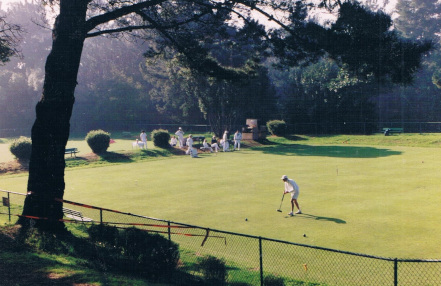
|
| Commuters on California Highway One could look down and see the sport being played on the Stern Grove lawns of the San Francisco Croquet Club, through the remaining traces of morning mist. |
I remember liking you instantly, Bob, probably because of your mischevious sense of humor . You mention in Part 1 [of the memoir] that you were good at introducing beginners to the game, and I can vouch for that.
After the clinic I immediately asked about membership and you tried to have me put it off until I was sure. I heard you do this several times to various newcomers at Stern Grove. After playing for a couple of years and becoming completely obsessed with the game, I understood your point of view. Later, when I would try and explain the game to friends and maybe feel them out for potential long-term enjoyment of the game, I was always terrified of overselling. I could not believe that anybody else would see this as a serious endeavor worthy of hours of time on the weekend. Golf, racquetball, tennis, hiking, biking, all of these make sense to the casual observer--but the rabid enthusiasm of croquet devotees doesn't.
The following weekend I was back at Stern Grove with a check and my high school friend Rob Haley. We were avid backyard players and he was just as enthusiastic about joining as I was. For about the next 3-4 years we probably spent 3 out of every 4 weekends (at least one day, often two) on the croquet lawn. We played in every club event that we could. I remember you called us "self-starters." I took that as a great compliment.
I played in the B-Flight of the 1992 SF Open. That was the first time I saw high level international players like Barrie Chambers and Tony Stephens. The following weekend I went up to Sonoma Cutrer and watched Robert Fulford complete a sextuple peel where he never missed his intended spot by more than 6 inches.
| WAYNE RODONI'S PERFECTIONISM |
|
Wayne Rodoni's perfectionism served the club in extraordinary and essential ways. He was the first of many champions at the club. For the sport, he designed and welded hoops for sand-based courts that set the standard for perfection. He invented a fast and accurate method of setting a court--something he did with able assistance from Rhys Thomas for every SFCC Open. His adaptation of a vise grip is considered by many the most precise hoop clamp in the world. Quick enough with a quip but reluctant to commit to ever putting anything in print, he talked easily enough when I called. He asked if I remembered the time when I had a golf croquet game between us locked up, with the winning hoop blocked straight-on by two balls, with Wayne's next ball to play about 20 feet away. How could I forget? He tried a double jump, and it worked--then he grinned and pretended he actually expected that to happen. Anyone would try to do the only thing that might possibly work in a situation like that. But only a seasoned sportsman would behave as if he expected the ideal outcome.
|
The 3 or 4 years I got to work on the SF Open were a blast. I loved helping with the schedule even though Wayne insisted on checking my work over and over. My favorite days were the practice days before the tournament. I would help lay out the courts with Wayne and usually Rhys Thomas. Once again, Wayne was a stickler for precision, but I learned so much from him.
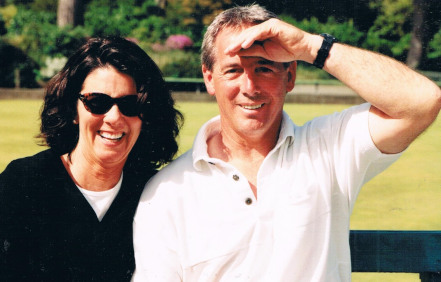
|
| Rodoni is with the bride that seems to have permanently distracted him from sports. |
Every year but one I partnered with Sal Esquivel in the doubles. I wonder whatever happened to him, he was fun to partner with and I think we made it to the semis one year.
I also am very proud to have had the opportunity to meet and play against John Solomon in the first SF Open he attended. Whenever I try and explain to a non-croquet friend what that represented I compare it to playing a competitive round of golf against Jack Nicklaus or getting to pitch against Willie Mays or Joe DiMaggio.
Somehow, probably because of better players not being available, I was selected for the 1998 Solomon Trophy at Bowdon in England. I won one of my singles matches and one of my doubles matches with my partner Britt Ruby. Both were very unexpected wins and definitely the high point of my croquet career. Britt and I also had the honor of playing American Doubles against John Solomon and Martin Murray in the President's Matches that preceded the main event.
I played my last SF Open in 1999 (also my last American Rules tournament). That was my best result as I made it to Sunday morning. 1999 was also the year I was invited to play in the World Championship at Sonoma Cutrer. I was a bundle of nerves and sucked the entire week but it was a blast to get to do what I had seen so many of my croquet idols do in the previous years; play in the SF Open as a warm-up for the WCC. Two weeks of croquet bliss.
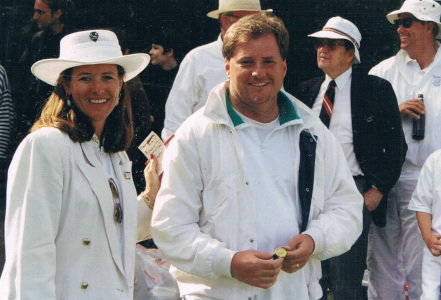
|
| Jim Audas chats with Anne Frost Robinson at the club's San Francisco Open in Golden Gate Park. |
The memories I cherish most about the SFCC, though, were those many many lazy weekend afternoons playing pick-up games with some of the best players in western croquet. The croquet was fun but the out-player kibitzing on the sideline was even better. So many topics, so much gossip, so many laughs.
This report is already a bit rambling and long. And I haven't even touched on Jerry [Stark] or Meadowood, or the guys at Sonoma Cutrer, especially your partner in crime Mike Orgill. Mike is possibly the most enjoyable person there is to sit next to as an out player. When I think of sitting in a group with Mike courtside at Sonoma Cutrer snickering endlessly at so many silly jokes and asides it really makes me miss the game.
From John Taves....
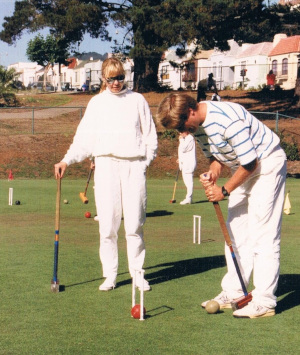
|
| John Taves must be demonstrating the jump shot to his wife Anne. |
We had been undefeated in our doubles matches in the Northwest Regionals. At that tournament we beat Rodoni and I am not sure who, but maybe Carl Hanson, with a nifty come-from-behind win in the finals. In a prior match, Phil Arnold and Tom Dunker were finishing. One of them just needed 2 more hoops and then stake both out for the win. I think it was Arnold that stuck in penult. Anne was just going to join me on the sidelines, but she hit me by mistake. This left her in a bad position, but there was no choice, she had to use Phil's ball in penult to run 2 and then go around and stake Tom out. She did, leaving me with 3 balls to run around. In other words, they didn't get another shot.
A while later in the SFCC doubles club championship Anne and I were thinking they should just give us the trophy. I can't remember how we did in the other matches, but I think we were poised to win the thing if we beat Alman and Breuer. We had beaten the best doubles teams, so there's no way we were going to lose to Alman and Breuer. We lost. Anne and I were so pissed off we couldn't speak for days. I am certain we both made mistakes, so neither of us could cheer up the other.
To second Jim's comments about sideline conversations. I can't forget Carl Hanson:
Carl (referring to some player that we are watching): "That's a PPP".
Me: "A what?"
Carl: "Perfect Pioneer Position"
Carl, a little while later: "That's a PPPP".
Me: "Huh?"
Carl: "Piss Poor Pioneer Position"
Anne and I certainly enjoyed it when Jim and Rob showed up. They were a ton of fun. Carl was generally always there.
Another from Jim Audas....
Out of the Pacific Northwest a voice from the past! Baba, things just got real in your little memory exercise! I briefly mentioned the Taves in my first recollection but since John has responded I feel compelled to contribute a bit more.
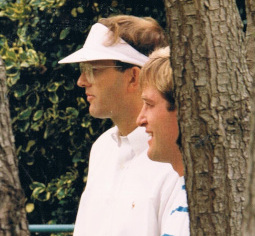
|
| Carl Hanson and John Taves view the action on the north lawn of Stern Grove from the central berm. |
Adding to John's Carl story , one of his other classic lines...if you were playing doubles with him and he wanted you to give him a rush, he would point to a very precise spot in front of his ball and ask you to put it on the spot. If you missed that spot by 2 feet and acted disgusted at your failure, the ever-positive Carl would chime in with, "No, no. That's perfect!"
| CARL HANSON'S STYLE |
|
Dr. Carl Hanson, who easily could have been a national champion by taking time away from his doctoring, engineered each of his croquet strokes with the precision one would want from a trained surgeon. Carl enjoyed mentoring weaker players, including me. After playing "out of my head" brilliant croquet, our partnership wound up in an SF Open finals against Rodoni and Mehas. I gave the game away in the last turn by missing a four-foot roquet, delivering the not-very-well-earned championship to Mehas and Rodoni. Carl and his wife Judith are retired physicians, so I wrote to him in Sandport, Idaho, and got back a big stack of photos and a brief letter, which said,in part, "We live in beautiful country with a politically challenging community. Croquet was for us a long time ago. We are now refined and busy with multiple activities--but the memories of the SFCC remain strong." Carl and Judith gave me a farewell party when I l left San Francisco to move to Florida to organize the National Croquet Center. Carl also has no idea what became of Ed Breuer.
|
The last time I ever played at Stern Grove was the 1999 Calzona [an annual match between California and Arizona, the strongest powers in American croquet at the time]. After the first night of play Carl, the non-playing captain, hosted a cocktail party at his home in San Mateo. That was the night Mic Mehas was putting rather aggressive moves on a young writer and friend of one of the other players who had come out to watch the matches. I remember commenting with Carl and a couple others about Mic's unabashed stick-too-it-ivness.
On the 2nd or 3rd day I ever played, you were arranging games with those in attendance and you set me up in an American Rules doubles slog with Wanda Lee Smith as a partner. I had played less than 5 games in my career and was told (by you) that Wanda Lee could teach me some of the tricks of the game. What she taught me was that I should get partner dead setting up her break (I use the term "break" loosely here) and then have her refuse to let me try to clear my deadness for the remainder of the 90-minute game. She kept telling me that I couldn't set up in front of my hoop because my opponent would "attack" and all would be lost. After about a month of playing, and getting to know the games of the various members in the B group, I learned from that moment on to ignore the croquet advice of Wanda Lee Smith.
One more aside before I get to John and Ann. I remember at the peak of our croquet fever, Rob Haley and myself would dream of moving up to Sonoma County so we could play all the time at Sonoma Cutrer. Rob is now Superintendent of Schools for Rhonert Park/Cotati. He lives in Windsor about 5 minutes from Sonoma-Cutrer and hasn't touched a mallet in at least 15 years.
The Taves presence at SFCC played a major factor in my early enthusiasm for the game. John and Ann were funny, smart, great croquet players, about the same age as me and were at Stern Grove as much as I was.
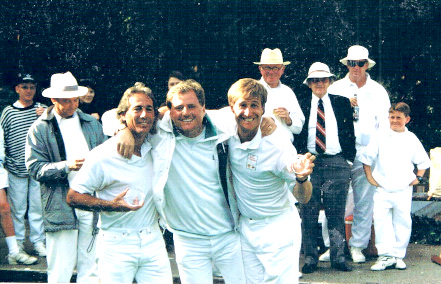
|
| Wayne Rodoni and John Taves have won the doubles trophy, as Audas congratulates them. |
John was, of course, a croquet Wunderkind and Ann was excellent as well. They gave me a target to shoot for and having them around with the likes of other top players like Wayne Rodoni made learning the strategy of the game easy.
What I remember most about John was he loved to argue for the sake of arguing. He may disagree, but that's what I remember. I think the story he shared about that doubles match with Ann is really illustrative. John was very competitive and loved to win croquet matches, but I always felt he was even more excited when Ann won a match against some "better" player. And he really loved playing and winning doubles with his wife.
During that period the group of regular players at Stern Grove would try and milk every last drop of daylight to get as many games as possible. In the waning moments of a game, John would start arranging the match-ups or partnerships for the next game and as soon as the in-progress game finished, John would flip a coin, look at his opponent(s) and declare "The coin is in the air." Not a moment was wasted, pleasantries and jokes could be exchanged between the out players.
Several favorite Tavesisms:
Break Down with Control--you are playing a break, miss an easy shot but somehow leave your opponent far enough away that when he misses you get your break back immediately.
Chunks on Deck--Apparently borrowed form John's sailing experience. This is breaking down, leaving the balls scattered in fairly close proximity so that your opponent has an easy pick-up.
3-Back Leave--Might have come from another source but John is the first one I heard use it. Association Rules, you are setting a New Standard Leave, after you place the two balls on the non playing side of 3-back you stuff the hoop leaving your opponent a 12 inch shot for a laid break.
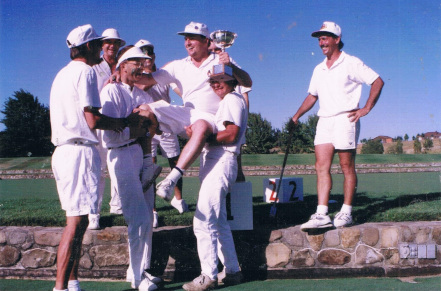
|
| Audas--for some reason--is being hoisted with the Golden Gate Challenge Cup trophy just won by the San Francisco team at Sonoma-Cutrer. |
John and Ann moving to Seattle was a real kick in the gut for the club. In the couple of years after they left Wayne started playing less, Sal Esquivel disappeared, Carl and Judy moved to Idaho, and Baba left for Florida. We went from a reliable 6-10 people showing up for regular weekend play to maybe 3-4. That's when I started working at Oakland Police and weekends became more and more difficult for me to play. By 1996 my main club was Sonoma-Cutrer because I could get regular mid-week play with Phil Arnold.
From Karen Collingwood.....
I lead a fairly active childhood, excelling in four square, tetherball, volleyball and ping pong. As an adult, not so much. It was years (after I gave up booze and cigarettes) before I convinced myself that exercise was also necessary for better health, so I joined the Sierra Club, the Car Camping division. The expeditions with the car campers were fun and actually included some short hikes but I realized that taking a few hikes each year was not really enough.
At that same time, the SF Chronicle published the green sheet on Monday which listed all the local sports activities/venues, where I finally found a listing that seemed to check all my personal boxes: easy-outdoor-exercise close to home. I showed up at 19th and Wawona for a free clinic on a Saturday and had so much fun and was such a "natural" (according to Bob Alman) that I almost joined the club on the spot.
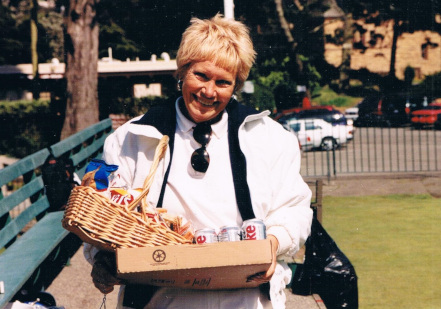
|
| Karen Collingwood is working hard at the Open, with a characteristic smile. |
Any reservations I may have had were assuaged by the reception I received when I stopped by the following weekend, attracted by a crowd in white on the lawn for a tournament of some sort. I was watching the activity from outside the fence when friendly onlookers inside invited me to join them. Rosemary and John Taylor spent a long time with me that afternoon, explaining the game/rules and introducing me to other club members.
So in the summer of 1987 I joined the San Francisco Croquet Club, bought a basic mallet from Bruce Atkinson and spent the next 24 years playing most weekends, sometimes after work on weekdays, on vacation in San Miguel de Allende or Maui, and at many tournaments in the western states and a few in the east.
My buddy Elaine Fong also joined that summer and we learned the game by attending the beginners clinics put on by the club and playing with Wanda Lee Smith and Virginia Snyder and anyone else who would play with us. Elaine hit the tournament circuit years before I worked up the confidence to venture out of state, but tournaments were the most fun and the SF Open that our club put on each year was the best, and not just in my opinion!
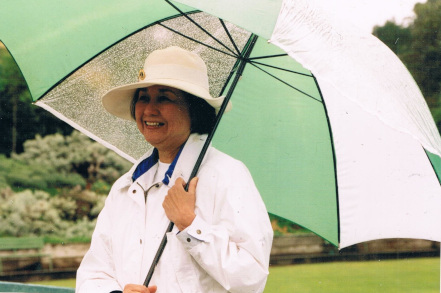
|
| Classic Elaine Fong, prepared for rain at the bowling lawns in Golden Gate Park. |
Elaine and I were eventually elected to the Club Board of Directors and added to the core planning group of Bob Alman, Ed Breuer, John Taylor and Wayne Rodoni, working the annual Open tournament for probably 10 years before it ceased altogether. She handled the money and the merchandise, while I handled the catering and the trophies. Our tournament offered more bang for your buck than any other tournament in the west, and every year we tried to do better without going in the red.
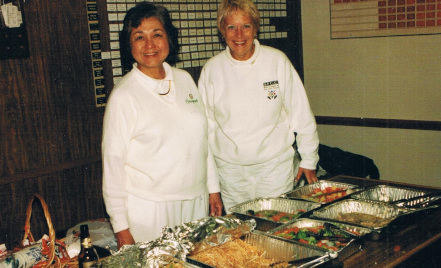
|
| Elaine Fong and Karen oversee the food service in the bowling clubhouse during the Open.. |
Pins to commemorate tournament participation were mandatory on the circuit, but we added souvenir glasses in 1990 and the trophies got bigger and heavier. We added fabulous red and white wines from Charlie Smiths' vineyard to complement the finals day luncheon; champagne to go with the carrot cake, and there was always a cold beer waiting for Mic Mehas at the end of the tournament.
One year, with 64 participants, we may have made some money. That year we had to rent two lawns in Oakland and catering was a real challenge. I played in most of the Opens, and collected trophies in some, so it was an exhausting time but great fun putting on a successful tournament enjoyed by all. So many fond memories associated with croquet....
I moved to Palm Springs in 2007.
From Mike Orgill....
After we had played our own version of guerrilla croquet in the city and industrial parks of San Francisco for over a year I happened on an article about croquet in the New York Times Sunday Magazine. It featured the USCA, Jack Osborn and the NY croquet club with pictures of the professional equipment. It mentioned a San Francisco Club and I talked with you about investigating the club. You were not that interested, favoring our own egalitarian version.
There it sat for a while until I came across an article in the San Francisco Chronicle about things to do during a football strike when people couldn’t watch their sport on TV and needed alternative activities. Tom Lufkin and the SF croquet club were mentioned. I called Tom, he told me about a tournament at Stern Grove, and I cajoled you and Helen to see what it was all about.
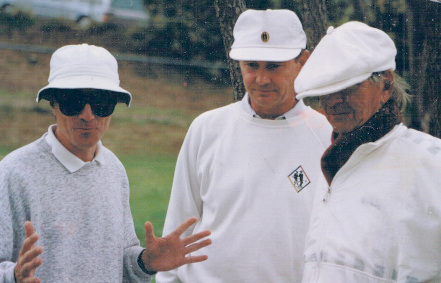
|
| Mike Orgill is describing something about so big to his solemn listeners, Bob Alman and Ellery McClatchy. |
I remember us pushing through the bushes surrounding the court on Sloat — the one that had the golf holes — and coming upon a Western Regional in full swing. Jack Osborn was there along with other players we would get to know well, such as the Arizona contingent. After that I was hooked. I remember that to join the club we had to pay an initiation fee of $250, a large amount for me at the time. Things were different in those days. New players weren’t exactly encouraged; you had to prove yourself. At least that’s the way it seemed to me.
New players weren’t coddled then in the way they are today. Tom presented us with a sheet showing the positions of the croquet shots, explained the American rules game, and threw us in the pool. The experienced members were interested in winning and expected us to make our own way. I now think this was good for us, toughened us.
The San Francisco Bay Area was then a major center of American croquet and a small group of dedicated and somewhat crazy people created it, essentially out of nothing. Major credit has to be given to Tom Lufkin McDonnell, Jane McDonnell, Brice Jones, Bill Harlan and others who created a laboratory for croquet in SF, Sonoma, and Napa. Then the upstarts came along and built on that foundation.
The most significant memory of the SFCC for me is the San Francisco Open and all the work that we did to establish and produce it. Bob Alman, Hans Peterson and I spearheaded the first one and it was a great success. We had a large field complete with some very interesting characters, and even though it was played on the old Sloat Boulevard courts which were small and in some cases festooned with golf holes, the competition was fierce.
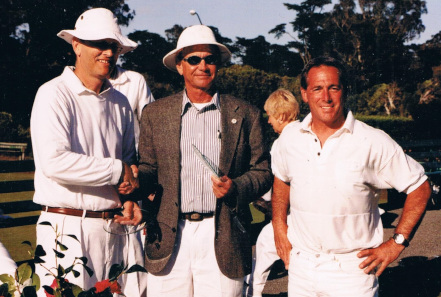
|
| Carl Hanson and Bob Alman are shaking hands for some reason, and Rodoni is also looking at whatever the three of them see. |
It was a high-quality tournament at a time when there were few if none on the west coast. The ironic thing is that as I write this I cannot remember who won, which shows me how important the winner is versus the overall impression the tournament left in my mind. As the years went on, the tournament grew in importance until it was one of, if not the most competitive USCA-rules tournament in the country.
Since the Sonoma-Cutrer tournament was staged around the same time, some of the world's croquet greats appeared at Stern Grove: Fulford, Bamford, Stephens and on and on.
Stern Grove (and with it the SF club) have fallen into desuetude and it's depressing calling up these memories. I don't think it's too much to call those long-ago SFCC times an era of greatness, and the contrast with today is all too stark in the light of that greatness.
Today Oakland and Sonoma remain as clubs carrying on the tradition. Can it come back to the level it was was? Probably not. But it was a joy to live through it while it lasted.
Although the San Francisco Croquet Club in Stern Grove has few active members in 2018, the north lawn is still being used for croquet. For information, email to sfcroquetclub@yahoo.com.